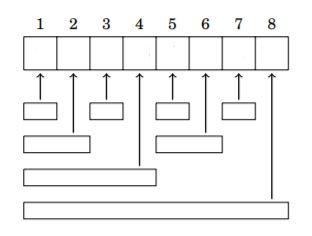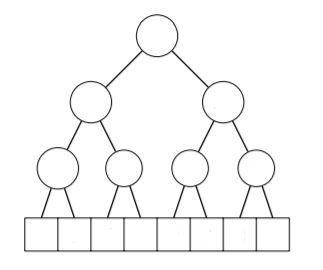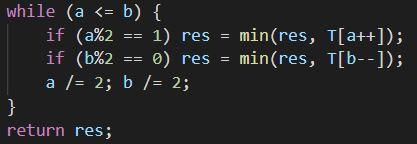Author's Disclaimer: This is my first blog in a series of blogs I plan on writing that introduce various types of problems to beginner competitive programmers through providing new ideas and proposing questions about them. That being said, whenever I ask "why?" in parenthesis, this is not me asking because I don't know. This is me encouraging you to stop and think through why something I said is true. I don't want to just give answers, I want to provoke thought. This is how we learn. If you're stuck, feel free to ask in the comments. I am purposefully leaving implementations vague.
Basic Sum Queries (Prefix Sums)
Let's say we have some array $$$A$$$ = $$$A_{1}$$$, $$$A_{2}$$$, ..., $$$A_{n}$$$. Given two indices $$$i$$$ and $$$j$$$, we are tasked to find the following sum.
For those unfamiliar with the notation, this is simply $$$A_{i} + A_{i+1} + ... + A_{j}$$$. If you don't understand the notation, use this fact to try and deduce what it means. This is important, as I will not explain notation further later on!
We could do this by iterating over each element and adding it to a sum which is initially 0. The complexity of this is $$$O(n)$$$ (why?), which is too slow if we are processing a bunch of these queries.
Instead, we can generate some useful information about each index in $$$O(n)$$$ and then solve each query in $$$O(1)$$$. Let $$$dp_{i} = \sum\limits_{k=0}^{i} A_{k}$$$. Thus, $$$\sum\limits_{k=i}^{j} A_{k} = dp_{j} - dp_{i-1}$$$. Watch the $$$i=0$$$ case!
These $$$dp$$$ values can be stored in another array (or you can change the original array if you're feeling edgy that day and the problem allows it).
Note: This is technically really simple dp, but I'm in a small minority by actually notating it this way. Most people put psums in a different category.
This is the cses problem that correlates with this skill: https://cses.fi/problemset/task/1646
Next, try using prefix sums to solve this: 466C - Количество способов
Sum Queries with a BIT
Note: BITs are probably more confusing than segment trees, so if this looks terrifying don't be afraid to skip this section.
Let's say we have the same task but an extra challenge is added. A new type of query is introduced in which we must add some value to one of the elements in the array. If we were to keep using the prefix sum method, suddenly we would have to rebuild the $$$dp$$$ array each time this type of query is called upon (why?). This is where a binary indexed tree (also known as a Fenwick tree) comes in. This uses bit operations (more precisely, powers of 2) to solve both types of queries in $$$O(\log n)$$$.
The main idea behind easily implementing this is that the largest power of two that divides some integer $$$k$$$ is k&(-k) (why?). We'll notate the largest power of two that divides $$$k$$$ as $$$☺(k)$$$ (this is obviously not official notation, please don't use it elsewhere or people will laugh at you). We then build a new array (we'll call it $$$T$$$ for tree) such that $$$T_{k}$$$ contains the sum of all elements in the sub-array that is of length $$$☺(k)$$$ and ends at index k.
To compute $$$\sum\limits_{i=0}^{k} A_{k}$$$, let $$$j = k$$$. Then, while(j > 0){ sum += T[j]; j -= j&(-j); }. As an exercise for the reader, try to think about how updating a value would work.
Both of these operations occur in $$$O(\log n)$$$ (why?).
This is a very confusing topic. Here is a diagram that may help (pulled from the cses handbook and edited for generalization purposes). This is also a good reminder to NOT make your BITs zero-based!

This is the cses problem that correlates with this skill: https://cses.fi/problemset/task/1648
Next, try to use a BIT to find the amount of inversions in an array. Don't be discouraged, this may be challenging! An inversion is a pair of indices $$$i < j$$$ such that $$$A_{i} > A{j}$$$.
Segment Trees (Iterative Implementation)
Let's say the task is no longer to find the sum of all elements in a range, but rather the minimum, maximum, or some other attribute of the range that would normally require an $$$O(n)$$$ iteration. Segment trees can do these efficiently ($$$O(\log n)$$$) and are often easier to understand than BITs (which can only handle sum queries). Before I get into detail, here's a diagram (again, copied and modified from the cses handbook) that should give you a pretty good idea of what we're working with.

Let's say we're working with minimum range queries. In other words, what is the minimum value in the range $$$[a,b]$$$. We use the fact that each note in this diagram (the original array is the bottom row) is the minimum of the two nodes below it. We can actually store this segment tree in an array $$$T$$$ that is twice the size of the original array such that $$$T_{i} = min(T_{2i}, T_{2i+1})$$$. These, similarly to BITs, should NOT be zero based.
Let $$$n$$$ be the size of the original array and we want to find the minimum value in $$$[a,b]$$$. First, add $$$n$$$ to both $$$a$$$ and $$$b$$$ since the original array is actually stored in the second half of $$$T$$$, which is the data we will be working with. Then, we'll let res=INF where INF is some arbitrarily large value (infinity). Below is an iterative implementation of a minimum query with this segment tree we built.

a /= 2; b /= 2; is simply moving up the tree (why?). Also, knowing that the modulus operations (a%2 and b%2) tell us whether a and b are right children or left children, consider why we only apply the operations in these certain conditions (refer back to the picture!).
I know this description is vague, but I am confident that anyone reading this, even if it takes a while, can think through why these things I'm saying are true. Trust me, it's very good for you!
You can edit values in the original array with a segment tree as well. Once you change the value at index $$$i$$$, divide $$$i$$$ by two and do this: while(i >= 1){ T[i] = min(T[2*i], T[2*i+1]); i /= 2; } (are you starting to see why this should NOT be zero-based?). The contents of this loop will vary depending on what your segment tree does.
Above I explained a segment tree build for minimum queries. Test your knowledge of this content with this cses problem: https://cses.fi/problemset/task/1649
Next, go back to the problem I gave you for the BIT and solve it with a segment tree instead: https://cses.fi/problemset/task/1648
Next, let's explore using a different operation: XOR. Solve this other cses problem (note that we don't need to update values in this one!): https://cses.fi/problemset/task/1650
Closing Thoughts
Firstly, thanks for reading this far. I was nervous writing a blog like this since it will most likely fall into one of two categories: too easy for the experienced or not enough detail for the learner. The reason I did this was to introduce a new kind of interactive learning. I encourage everyone who is trying to learn new topics to pick up as much as they can from their own intuition and exploration. I don't want to discourage people who can't figure some of this out. That's ok! I started with a harder topic for a reason. Please let me know what you guys think in the comments. What topics do you want to see next? Do you like this more interactive style of learning or would you prefer more answers than questions? Are there any mistakes I made?
Thanks for reading. Happy coding! -Jellyman






